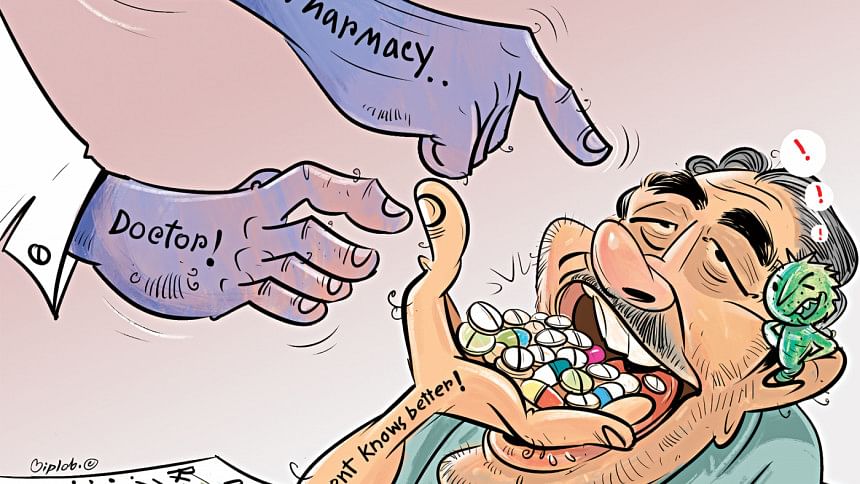Germs winning over drugs

Drugs that used to successfully fight diseases are gradually becoming ineffective due to decades of malpractice: intake of over-prescribed or self-prescribed medicines.
As if it's not enough of a grave news, germs that cause diseases are now becoming all the more powerful having been fed with wrong dosages of drugs, according to multiple research and studies in Bangladesh.
Most of the microorganisms -- viruses, bacteria, fungi and protozoa -- have been found to be resistant to a good number of drugs available in the market.
"Forget bacteria, even the fungi (like candida, mucor and the aspergillus), which cause common skin infections, have now turned difficult to treat with conventional drugs," laments Prof Ahmed Abu Saleh, of the Department of Microbiology and Immunology (DMI) at the Bangabandhu Sheikh Mujib Medical University (BSMMU).
A pioneer in the field of research on "superbugs", the drug-resistant germs that kill some 3,500 people around the world every day, Prof Saleh explained to The Daily Star how the typhoid germ (Salmonella Typhi) is threatening to break loose again at community level.
Co-trimoxazole was the main antibiotic to cure typhoid 20 years ago and replaced by ciprofloxacin, as it became ineffective following indiscriminate uses. This replacement drug too turned almost ineffective against the water-borne disease. Then came the ceftriaxone, which is still working well. But there is no alternative to this drug in the pipeline as yet.
"If ceftriaxone loses efficacy, typhoid will break out in the community. The only way we can prevent this disaster is by refraining from prescribing high-end antibiotics outside hospitals," he said.
Out of over 100, over 85 antibiotics are available in the Bangladesh market for treating around 40 minor or life-threatening diseases. However, no credible study is done yet to bracket drugs that have turned ineffective.
Multiple studies, including the January-June 2021 surveillance study of the DMI, show there are at least a dozen of bacteria that pose the greatest threat to the human and animal health in the country.
There is no scientific data on deaths or sufferings due to antimicrobial resistance at the community level in the country. But the clinical data of DMI depicts a very worrying picture.
Researchers, between January and June last year, examined 1,250 bacteria that were collected from nearly 9,000 samples (blood, swab, sputum, stool, etc) of the patients at BSMMU and tested around 30 antibiotics against those.
Shockingly, not a single bacterium was found that was not resistant to at least one drug, said Prof Abu Saleh.
"The uncontrolled infection due to superbugs is a daily incident inside ICUs. Patients come here, get infected with new superbugs from other patients easily and eventually die," he said.
The surveillance study of the Institute of Epidemiology, Disease Control (IEDCR), which was published in November last year, on the 10 bacteria collected from nine medical colleges across the country between 2017 and 2021 also backs up the BSMMU findings.
In both studies, it was found that five of the most critical medicines listed by the WHO are progressively becoming ineffective.
Sadly, a section of doctors, pharmacies and patients are to blame for the failing of drugs.
Throughout the pandemic, doctors prescribed unnecessary antibiotics for Covid-19 patients in the hospitals in 83 percent of cases, according to a 2021 IEDCR study.
"The gross misuse was due to misconception by both the physicians and people. We will see its impact once the Covid-19 is over," Prof Zakir Hossain Habib, the lead investigator and head of microbiology at the IEDCR, told The Daily Star.
As many as 60 percent of the patients take medicines without consulting doctors or take medicines on advices from informal providers like drug sellers and quacks; 25 percent of the patients suffer due to costly non-listed drugs prescribed by doctors, according to a November report last year by the Health Economics Unit of the health ministry.
Sale of drugs without prescription is prohibited but not punishable under the Drug Policy of 2016, and it is helping the malpractice to go on.
This must stop now, insists Prof Saleh, adding that no physicians, outside hospitals, should be allowed to prescribe high-end antibiotics.
"There should be a separate list of antibiotics for the registered doctors, consultants and the doctors at the hospitals. Most probably, this is the only way we can save the remaining few drugs in our hands, until a new drug is there," he said.
It takes years of painstaking research and billions of dollars in investment to invent an antibiotic, develop a drug and market it for people's use.
Only four new classes of antibiotics, in terms of novel mechanism to target the bacteria, were invented since 2000, compared to the 63 put to clinical use between 1980 and 2000.
Unfortunately, bacteria resistant to each of these new drugs have already been detected, according to an article published in harverd.edu in 2018.
"Currently, many drugmakers are producing cocktail antibiotics (a combination of multiple antibiotics). It may work for the next 2-5 years, but then there will be no option left as no new antibiotics will be available in the next 10 years," Prof Mohammad Riazul Islam of Biochemistry and Molecular Biology at Dhaka University told The Daily Star.

 For all latest news, follow The Daily Star's Google News channel.
For all latest news, follow The Daily Star's Google News channel. 



Comments